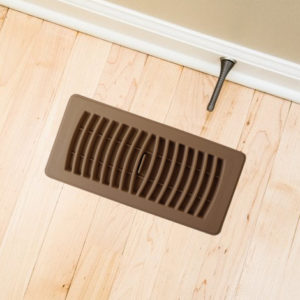 If you’re an HVAC technician, you’ve heard it again and again: “This room never fully heats up or cools down.” It’s one of the most common complaints homeowners and building managers make about their HVAC systems, and the solution might be simpler than you think.
If you’re an HVAC technician, you’ve heard it again and again: “This room never fully heats up or cools down.” It’s one of the most common complaints homeowners and building managers make about their HVAC systems, and the solution might be simpler than you think.
Check the registers
When responding to one of these calls and assessing the efficiency of an HVAC system, it can be easy to overlook some of the finer details. Next time start by taking a look at the registers being used and your investigation could be over before it’s begun.
The reason? Many homeowners choose to install decorative registers. Instead of traditional vanes, these registers feature stylish flourishes and designs in the free area of the register. These types of registers were especially popular several decades ago, so if you’re troubleshooting an HVAC system’s efficiency in an older home this could be a culprit.
If you’re an HVAC technician searching for answers to why a system is underperforming, the registers can go a long way to explaining why a specific room is constantly uncomfortable. Let’s look at the science behind why.
Why louvered registers are the most effective
The efficiency of any HVAC system depends on proper, unobstructed airflow. Without it, warm air rises and accumulates at the ceiling. This is known as air stratification. When a homeowner complains that a particular room is never fully heating up (or cooling down, in the case of built-in air conditioning) poor air mixing is often the culprit.
This is why effective registers feature a finely tuned louvered design on each vane of the register—the louvers help direct and propel air into a room with enough force to mix hot and cool air throughout the room. This is known as “throw” or air entrainment.
The effectiveness of air entrainment in any given room is contingent on how air passes from the ductwork through the register. If the register features a traditional louvered design, air is compressed as it passes through the register and forced out at a higher speed, similar to placing your thumb over the end of a garden hose—water shoots out faster and travels further. With a louvered register, air shoots out of the ductwork faster and travels farther in the room.
With greater velocity comes greater throw and more effective air mixing. When air is effectively mixed the temperatures in a room are stabilized, including on surfaces that directly impact comfort, such as couches and beds.
Replace decorative registers with louvered ones
Despite their good looks, decorative registers can be very disruptive to air flow in a home. Because they forgo louvers for stylish flourishes, they actively degrade efficiency and prevent proper air mixing.
If you’re advising a client on how to improve their HVAC system’s efficiency, one of the smartest and simplest recommendations you can make is to replace decorative registers with louvered registers designed to optimize airflow.



